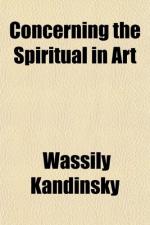In the past and even today much talk is heard of “personality” in art. Talk of the coming “style” becomes more frequent daily. But for all their importance today, these questions will have disappeared after a few hundred or thousand years.
Only the third element—that of pure artistry—will remain for ever. An Egyptian carving speaks to us today more subtly than it did to its chronological contemporaries; for they judged it with the hampering knowledge of period and personality. But we can judge purely as an expression of the eternal artistry.
Similarly—the greater the part played in a modern work of art by the two elements of style and personality, the better will it be appreciated by people today; but a modern work of art which is full of the third element, will fail to reach the contemporary soul. For many centuries have to pass away before the third element can be received with understanding. But the artist in whose work this third element predominates is the really great artist.
Because the elements of style and personality make up what is called the periodic characteristics of any work of art, the “development” of artistic forms must depend on their separation from the element of pure artistry, which knows neither period nor nationality. But as style and personality create in every epoch certain definite forms, which, for all their superficial differences, are really closely related, these forms can be spoken of as one side of art—the subjective. Every artist chooses, from the forms which reflect his own time, those which are sympathetic to him, and expresses himself through them. So the subjective element is the definite and external expression of the inner, objective element.
The inevitable desire for outward expression of the objective element is the impulse here defined as the “inner need.” The forms it borrows change from day to day, and, as it continually advances, what is today a phrase of inner harmony becomes tomorrow one of outer harmony. It is clear, therefore, that the inner spirit of art only uses the outer form of any particular period as a stepping-stone to further expression.
In short, the working of the inner need and the development of art is an ever-advancing expression of the eternal and objective in the terms of the periodic and subjective.
Because the objective is forever exchanging the subjective expression of today for that of tomorrow, each new extension of liberty in the use of outer form is hailed as the last and supreme. At present we say that an artist can use any form he wishes, so long as he remains in touch with nature. But this limitation, like all its predecessors, is only temporary. From the point of view of the inner need, no limitation must be made. The artist may use any form which his expression demands; for his inner impulse must find suitable outward expression.
So we see that a deliberate search for personality and “style” is not only impossible, but comparatively unimportant. The close relationship of art throughout the ages, is not a relationship in outward form but in inner meaning. And therefore the talk of schools, of lines of “development,” of “principles of art,” etc., is based on misunderstanding and can only lead to confusion.




